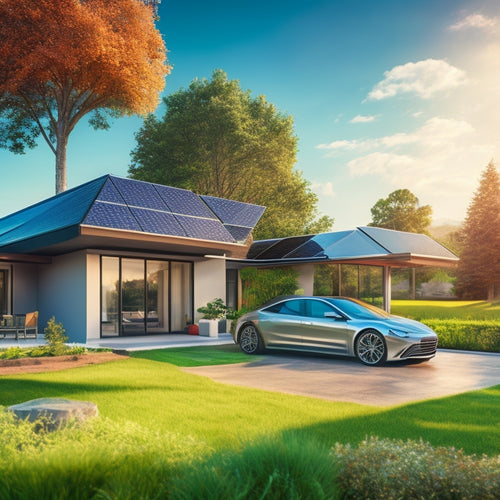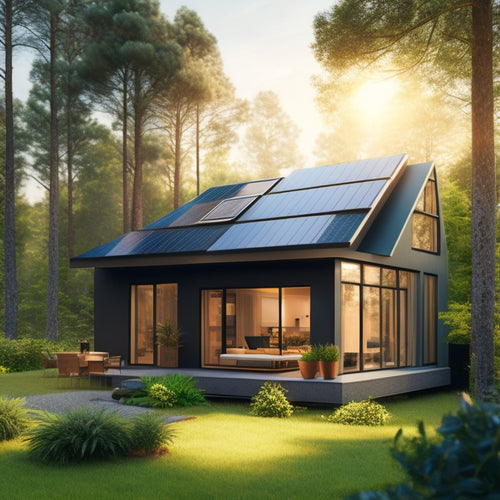
7 Steps to Understanding the Average Cost of Solar Panels for Your House
Share
To calculate the average cost of solar panels for your house, you'll need to follow seven key steps. First, determine your energy needs by calculating your daily energy consumption. Then, assess your roof's condition, considering its age, size, and orientation. Next, understand your system size options, choosing the right equipment, including solar panels and inverters. Evaluate installation company costs, considering labor, equipment, and additional services. Calculate your total system costs, factoring in component and installation costs. Finally, claim incentives and rebates, such as the Solar Investment Tax Credit. By following these steps, you'll gain a clear understanding of the costs involved, and next, you'll be able to make an informed decision that suits your energy needs.
Key Takeaways
- Daily energy consumption, roof size, and panel type determine the required solar system size and overall energy output.
- Solar panel costs range from $2.50 to $3.50 per watt, varying by brand and efficiency, and account for a significant portion of total system cost.
- Labor costs, permits, inspections, and equipment rental costs contribute to the total system cost, with labor costs making up 8%-12% of the total.
- Claiming federal and state incentives, such as the Solar Investment Tax Credit, and local rebates can significantly reduce the upfront cost of solar panels.
- Total system costs include component costs, installation costs, and additional expenses, and can vary greatly depending on the complexity of the project.
Determining Your Energy Needs
Your daily energy consumption is the foundation of determining the right size of your solar panel system. To accurately assess your energy needs, you'll need to calculate your total daily energy consumption in watt-hours (Wh). This involves adding up the energy usage of all your appliances, lights, and devices. You can find this information on your utility bills or by using an energy monitoring device.
A key factor in determining your energy needs is your energy usage patterns. Are you home during the day, or are you away at work? Do you have energy-intensive appliances like air conditioners or electric water heaters? Understanding your energy usage patterns will help you determine the ideal size of your solar panel system.
Solar efficiency also plays a vital role in determining your energy needs. The more efficient your solar panels, the less energy you'll need to generate to meet your daily energy consumption.
Assessing Your Roof's Condition
When evaluating your roof's condition, you'll need to take into account its age, as older roofs may require more extensive repairs or even replacement before installing solar panels.
The size of your roof is also essential, as it will impact the number of panels you can fit and the overall energy output.
Roof Age Matters
Because your home's roof is an essential component of the solar panel installation process, examining its condition is vital.
You'll want to take into account the roof's age, as it notably impacts the installation process and overall cost. An older roof may require replacement before solar panels can be installed, adding to the upfront cost. On the other hand, a newer roof with a longer lifespan can guarantee a smoother installation process.
When evaluating your roof's condition, you'll also want to inspect the roof materials and their compatibility with solar panels. For instance, asphalt shingles are a common and compatible choice, while clay or slate tiles may require additional installation considerations.
Additionally, the roof orientation plays an important role in determining the best placement of solar panels. A south-facing roof with minimal shading is ideal, but an east- or west-facing roof can still be suitable with proper installation.
Roof Size Importance
The size of your roof plays a significant role in determining the number of solar panels you can install, which in turn affects the overall cost of the system. To assess your roof's condition, you need to evaluate its size, orientation, and any potential obstructions. A larger roof can accommodate more solar panels, increasing the system's overall energy production. However, a larger system also means higher upfront costs.
When evaluating your roof's size, examine its orientation as well. A south-facing roof receives the most sunlight, making it ideal for solar panels. East- and west-facing roofs also work well, but north-facing roofs may not be suitable due to limited sunlight.
Additionally, conduct a shading analysis to identify any obstacles that could block sunlight, such as trees, chimneys, or skylights. This analysis will help you determine the best placement of solar panels to maximize energy production.
Understanding System Size Options
How much power do you need your solar panel system to generate? This is an essential question to answer when understanding system size options. The amount of power you need depends on your energy usage, roof size, and the type of solar panels you choose.
| System Size (kW) | Average Annual Energy Production (kWh) |
|---|---|
| 3-4 kW | 4,500-6,000 kWh |
| 5-6 kW | 7,500-9,000 kWh |
| 7-8 kW | 10,500-12,000 kWh |
| 9-10 kW | 13,500-15,000 kWh |
| 11-12 kW | 16,500-18,000 kWh |
When deciding on a system size, consider your energy storage needs. If you want to store excess energy generated during the day for use at night or during power outages, you may need a larger system. Additionally, different solar panel types have varying efficiencies, which can impact the overall system size required to meet your energy needs. By understanding your power needs and system size options, you can make an informed decision about the best solar panel system for your house.
Choosing the Right Equipment
Two essential components of your solar panel system are the panels themselves and the inverter. The type of panels you choose will impact your system's performance and cost.
You'll need to decide between monocrystalline, polycrystalline, and thin-film panel types, each with its own benefits and drawbacks. Monocrystalline panels are the most efficient but also the most expensive, while thin-film panels are more budget-friendly but less efficient.
The inverter is responsible for converting the DC power generated by your panels into AC power for your home.
You'll need to choose from string inverters, microinverters, and power optimizers. String inverters are the most common and cost-effective option, but they can be less efficient if one panel is shaded. Microinverters, on the other hand, optimize energy production for each individual panel, but they're more expensive.
Power optimizers offer a balance between the two. By selecting the right equipment for your solar panel system, you'll guarantee maximum energy production and savings.
Evaluating Installation Company Costs
Selecting a reputable installation company is essential to ensuring your solar panel system is installed correctly and efficiently. You'll want to research and evaluate potential companies based on their experience and reputation. A company with a proven track record of successful installations will have the necessary knowledge to handle any challenges that may arise during the installation process.
When evaluating installation company costs, you should consider factors such as labor costs, equipment costs, and any additional services they may provide. Be sure to ask about their installation process, including the timeline, permits, and inspections required.
You'll also want to inquire about their warranty and maintenance services.
It's essential to get quotes from multiple companies and compare their prices, services, and reputations. Check online reviews, ask for referrals, and verify their licenses and certifications.
Calculating Total System Costs
You'll need to calculate the total system costs by considering two key factors: system component costs, which include the expense of solar panels, inverters, and mounting hardware, and system installation costs, which encompass labor, permitting, and inspection fees.
These costs will vary depending on the size and complexity of your solar panel system.
System Component Costs
Your solar panel system's total cost comprises various component expenses, which can vary depending on the specific technology and quality chosen. These components include solar panels, inverters, mounting hardware, and monitoring systems. The type and quality of these components considerably impact the overall cost of your system.
You'll need to take into account the cost of solar panels, which can range from $2.50 to $3.50 per watt, depending on the brand, quality, and efficiency. Inverter types, such as string inverters, microinverters, or power optimizers, also vary in price, with string inverters being the most cost-effective option.
Battery storage, which is optional, can add considerable upfront costs, but provides backup power during grid outages.
Additionally, you'll need to factor in the cost of mounting hardware, including racking and tracking systems, as well as monitoring systems that track your system's performance. These components may seem minor, but they're essential to guarantee your system operates efficiently and safely.
System Installation Costs
The installation company's labor costs, permits, and other miscellaneous expenses account for a significant portion of the total system cost, ranging from 10% to 20% of the overall expense. As you calculate the total system cost, it's crucial to take into account these installation costs.
| Installation Cost Category | Estimated Cost Range |
| Labor Costs | 8% - 12% of total system cost |
| Permits and Inspections | 1% - 3% of total system cost |
| Installation Equipment Rental | 1% - 2% of total system cost |
| Travel Fees (if applicable) | 0.5% - 1% of total system cost |
| Miscellaneous Expenses (office, etc.) | 0.5% - 1% of total system cost |
When evaluating financing options for your solar panel system, you'll want to take into account the installation timeline as well. Typically, the installation process takes anywhere from a few days to several weeks, depending on the complexity of the project. Be sure to discuss the installation timeline with your chosen installation company to ascertain it aligns with your expectations.
Claiming Incentives and Rebates
Opportunity knocks in the form of incentives and rebates, markedly reducing the financial burden of switching to solar power. As you investigate the average cost of solar panels for your house, it's crucial to take advantage of these benefits.
You're eligible for federal incentives, such as the Solar Investment Tax Credit (ITC), which allows you to claim a tax credit of 26% of your total solar panel system cost. Additionally, state rebates and local programs can provide further financial relief.
For instance, some states offer rebates ranging from $0.50 to $1.00 per watt, while local governments may provide property tax exemptions or reduced utility bills. You can also consider financing options, like solar loans or power purchase agreements, to spread the cost over time.
Frequently Asked Questions
Can I Install Solar Panels Myself to Save Money?
You're considering a DIY installation to save money, but be cautious: while it may seem like a cost-effective option, improper installation can lead to reduced efficiency, safety hazards, and even void your warranty, ultimately negating any cost savings.
How Long Does a Typical Solar Panel Warranty Last?
You're likely expecting a measly 5-year warranty, but think again! Most solar panels come with an astonishing 25-year warranty coverage, boasting impressive warranty terms that'll give you peace of mind for a quarter of a century - or even longer!
Are Energy Storage Systems Compatible With Solar Panels?
You'll find that energy storage systems are indeed compatible with solar panels, enhancing energy efficiency by storing excess energy generated during the day for later use, and while installation costs may be higher, they're worth it for the added benefits.
Can Solar Panels Be Installed on a Metal Roof?
As you envision a sustainable future, you wonder: can solar panels be installed on a metal roof? Yes, they can! Metal roof advantages include durability and water-tightness, but installation considerations, like specialized mounting systems, must be factored in to guarantee a seamless integration.
Are Solar Panels Affected by Weather Conditions Like Hail?
You'll be relieved to know that modern solar panels are designed with durability in mind, incorporating hail damage prevention features like tempered glass and strong framing to withstand harsh weather conditions, ensuring your investment remains protected.
Conclusion
You've made it to the final step in understanding the average cost of solar panels for your house. Now that you've considered your energy needs, roof condition, system size, equipment, installation company costs, and total system costs, you're ready to make an informed decision. Don't let the complexity of the process hold you back - visualize your system costs as a pie chart, with each component making up a slice. This will help you see how each factor contributes to the overall cost, giving you confidence in your investment.
Related Posts
-

What Solar Panels Work Best With EVS Online?
When shopping for solar panels online to power your electric vehicle, look for high-efficiency models that can withst...
-

Planning for an Electric Vehicle-Friendly Urban Future
As you plan for an electric vehicle-friendly urban future, you'll need to integrate high-power charging stations, sma...
-

Reduce Solar Panel Cost for Your Small Home
By evaluating your energy needs, choosing the right installer, and selecting cost-effective solar panel options, you ...


